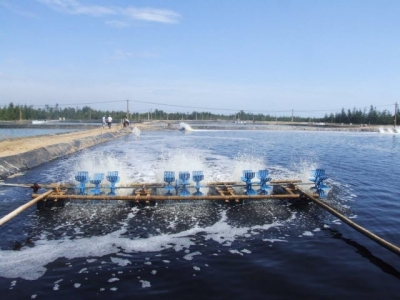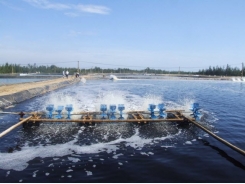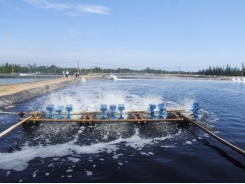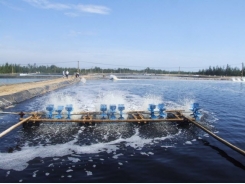The importance of biosecurity and disinfection in aquaculture (Part 2)

Biosecurity involves following strict management protocols to prevent specific pathogens from entering a system or reducing the numbers. A good understanding of pathogen reservoirs is important. Quarantine, sanitation and disinfection are all important components of biosecurity.
Quarantine, defined as the isolation of an organism or group of organisms to prevent the introduction or spread of infectious disease, is a standard procedure that is extremely important in aquaculture. In practical terms, quarantine is a standard set of procedures that should be observed to prevent the introduction of pathogens or diseases into a population of fish, prawn and shrimp in aquaculture. The quarantine protocols should be strictly adhered and should follow as many of the following protocols as are practical:
- testing of a sample of shrimp, prawn and fish prior to bringing them onto the facility.
- all-in, all-out stocking procedures.
- isolation or separation from other populations for a period of time (depending upon species, diseases of concern, the system)
- feeding observation and diet adjustment.
- sampling and proper treatment.
- reduction or elimination of infectious pathogens.
- disease prevention strategies.
Sanitation and Disinfection, Good sanitation and disinfection procedures reduce the numbers of disease causing organisms present within a given system and prevent or reduce the spread of disease causing organisms from one system to another.
Recommended Sanitation and Disinfection Protocols to prevent or reduce the pathogen load in a system include:
Proper attention to food sources:
1/ be careful with live foods, although live or fresh foods can be a good source of nutrients, these may also be a source of pathogens.
2/ ensure proper storage(in a cool, dry location) and usage (fallow manufacturers recommendations/expiration date) of manufactured feeds to prevent loss of nutrients and build up of pathogens or toxins.
Good overall system maintenance and cleanliness to reduce environments that will favor pathogens and parasites
1/ good husbandry (such as nutrition, water and soil quality etc).
2/ regular monitoring of excess organic matter and control strategies.
3/ backwash and treatment of filters as needed to reduce organic loading in hatcheries.
4/ washing and disinfection of air and water pumps and lines in hatcheries.
5/ flush sediment out of water lines as needed and disinfect them.
6/ maintain proper sanitisation disinfection strategies.
7/ keep nets and other equipment off the floor to control contamination and keep them sterile.
8/ Pull dead and moribund culture organisms as soon as possible and dispose of appropriately.
9/ Avoid cross contamination of equipment or water from one system to another.
10/ Use disinfectants for equipment including nets and footbaths (placed at strategic locations around the facility, e.g., at the entrance and exit of quarantine buildings, hatcheries, farms and other systems)
Biosecurity Programme for Shrimp Production Sector:
The major implementation of any biosecurity measures is always going to be in the hatcheries and in the growing ponds. However, besides good management practices and treatments in hatcheries and ponds there are biosecurity measures which should be put into place:
1/ Identify all vectors that can transmit disease from one place to another. Man is a major source of contamination. Anybody working with shrimp in several ponds should wash his/her hands, legs and feet with proper disinfection solutions, after handling equipment or animals and before moving to work on the next pond. Other vectors of disease transmission include crabs, rodents wild birds etc. which can contaminate the water in ponds. These vectors should be kept in control completely in the vicinity of aquaculture practices.
2/ Do not share equipment between ponds unless necessary. In these cases, disinfect all equipment prior to being re-used.
3/ Ensure that the site is limited to one combined entrance and exit to establish a secure Biosecurity perimeter. Restrict access to the hatcheries and farms to authorized persons only.
4/ Ensure that all vehicles have been cleaned and disinfected prior to arrival at site.
5/ Keep clean all surrounding areas of the hatchery or farm. After cleansing disinfect all surrounding areas of the hatchery or farm.
6/ Thoroughly clean all equipment such as sampling tubs, trays, nets etc., rinse with clean water and then disinfect.
Problem-Solving Approaches
Strictly adhering to the principles of biosecurity and good husbandry management will prevent many disease outbreaks. However, problems that may lead to disease will arise even in the best- managed systems and a scientific and methodical approach will help determine the best course of action, reduce losses and get the system and shrimp back to normal. Record keeping is an important tool in this approach.
Problems may or may not result in diseased shrimp or fish. The key to preventing disease and reducing losses is early detection of any abnormalities in the system or the shrimp/fish. Early detection relies on daily monitoring of water quality, general system checks and observing shrimp/fish behavior, shrimp/fish appearance and mortalities. Optimal water quality should be determined for the species being held as it may vary among species, life stages or systems.
Related news
Tools

Phối trộn thức ăn chăn nuôi

Pha dung dịch thủy canh

Định mức cho tôm ăn

Phối trộn phân bón NPK

Xác định tỷ lệ tôm sống

Chuyển đổi đơn vị phân bón

Xác định công suất sục khí

Chuyển đổi đơn vị tôm

Tính diện tích nhà kính

Tính thể tích ao




 The importance of biosecurity and disinfection in aquaculture…
The importance of biosecurity and disinfection in aquaculture…  The importance of biosecurity and disinfection in aquaculture…
The importance of biosecurity and disinfection in aquaculture…